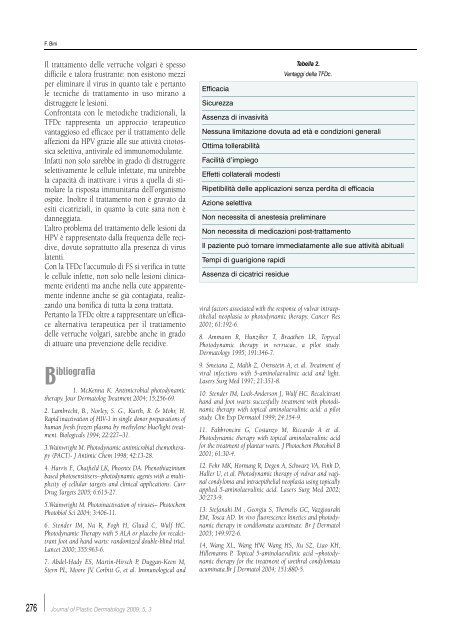Vol. 5, n. 3, September-December 2009 - Salute per tutti
Vol. 5, n. 3, September-December 2009 - Salute per tutti
Vol. 5, n. 3, September-December 2009 - Salute per tutti
You also want an ePaper? Increase the reach of your titles
YUMPU automatically turns print PDFs into web optimized ePapers that Google loves.
F. Bini<br />
Il trattamento delle verruche volgari è spesso<br />
difficile e talora frustrante: non esistono mezzi<br />
<strong>per</strong> eliminare il virus in quanto tale e <strong>per</strong>tanto<br />
le tecniche di trattamento in uso mirano a<br />
distruggere le lesioni.<br />
Confrontata con le metodiche tradizionali, la<br />
TFDc rappresenta un approccio terapeutico<br />
vantaggioso ed efficace <strong>per</strong> il trattamento delle<br />
affezioni da HPV grazie alle sue attività citotossica<br />
selettiva, antivirale ed immunomodulante.<br />
Infatti non solo sarebbe in grado di distruggere<br />
selettivamente le cellule infettate, ma unirebbe<br />
la capacità di inattivare i virus a quella di stimolare<br />
la risposta immunitaria dell’organismo<br />
ospite. Inoltre il trattamento non è gravato da<br />
esiti cicatriziali, in quanto la cute sana non è<br />
danneggiata.<br />
L’altro problema del trattamento delle lesioni da<br />
HPV è rappresentato dalla frequenza delle recidive,<br />
dovute soprattutto alla presenza di virus<br />
latenti.<br />
Con la TFDc l’accumulo di FS si verifica in tutte<br />
le cellule infette, non solo nelle lesioni clinicamente<br />
evidenti ma anche nella cute apparentemente<br />
indenne anche se già contagiata, realizzando<br />
una bonifica di tutta la zona trattata.<br />
Pertanto la TFDc oltre a rappresentare un’efficace<br />
alternativa terapeutica <strong>per</strong> il trattamento<br />
delle verruche volgari, sarebbe anche in grado<br />
di attuare una prevenzione delle recidive.<br />
B ibliografia<br />
1. McKenna K. Antimicrobial photodynamic<br />
therapy. Jour Dermatolog Treatment 2004; 15:256-69.<br />
2. Lambrecht, B., Norley, S. G., Kurth, R. & Mohr, H.<br />
Rapid inactivation of HIV-1 in single donor preparations of<br />
human fresh frozen plasma by methylene blue/light treatment.<br />
Biologicals 1994; 22:227–31.<br />
3.Wainwright M. Photodynamic antimicrobial chemotherapy<br />
(PACT)- J Antimic Chem 1998; 42:13-28.<br />
4. Harris F., Chatfield LK, Phoenix DA. Phenothiazinium<br />
based photosensitisers--photodynamic agents with a multiplicity<br />
of cellular targets and clinical applications. Curr<br />
Drug Targets 2005; 6:615-27.<br />
5.Wainwright M. Photoinactivation of viruses– Photochem<br />
Photobiol Sci 2004; 3:406-11.<br />
6. Stender IM, Na R, Fogh H, Gluud C, Wulf HC.<br />
Photodynamic Therapy with 5 ALA or placebo for recalcitrant<br />
foot and hand warts: randomized double-blind trial.<br />
Lancet 2000; 355:963-6.<br />
7. Abdel-Hady ES, Martin-Hirsch P, Duggan-Keen M,<br />
Stern PL, Moore JV, Corbitt G, et al. Immunological and<br />
Efficacia<br />
Sicurezza<br />
Assenza di invasività<br />
Tabella 2.<br />
Vantaggi della TFDc.<br />
Nessuna limitazione dovuta ad età e condizioni generali<br />
Ottima tollerabilità<br />
Facilità d’impiego<br />
Effetti collaterali modesti<br />
Ripetibilità delle applicazioni senza <strong>per</strong>dita di efficacia<br />
Azione selettiva<br />
Non necessita di anestesia preliminare<br />
Non necessita di medicazioni post-trattamento<br />
Il paziente può tornare immediatamente alle sue attività abituali<br />
Tempi di guarigione rapidi<br />
Assenza di cicatrici residue<br />
viral factors associated with the response of vulvar intraepithelial<br />
neoplasia to photodynamic therapy. Cancer Res<br />
2001; 61:192-6.<br />
8. Ammann R, Hunziker T, Braathen LR, To p y c a l<br />
Photodynamic therapy in verrucae, a pilot study.<br />
Dermatology 1995; 191:346-7.<br />
9. Smetana Z, Malik Z, Orenstein A, et al. Treatment of<br />
viral infections with 5-aminolaevulinic acid and light.<br />
Lasers Surg Med 1997; 21:351-8.<br />
10. Stender IM, Lock-Anderson J, Wulf HC. Recalcitrant<br />
hand and foot warts succesfully treatment with photodinamic<br />
therapy with topical aminolaevulinic acid: a pilot<br />
study. Clin Exp Dermatol 1999; 24:154-9.<br />
11. Fabbroncini G, Costanzo M, Riccardo A et al.<br />
Photodynamic therapy with topical aminolaevulinic acid<br />
for the treatment of plantar warts. J Photochem Photobiol B<br />
2001; 61:30-4.<br />
12. Fehr MK, Hornung R, Degen A, Schwarz VA, Fink D,<br />
Haller U, et al. Photodynamic therapy of vulvar and vaginal<br />
condyloma and intraepithelial neoplasia using topically<br />
applied 5-aminolaevulinic acid. Lasers Surg Med 2002;<br />
30:273-9.<br />
13. Stefanaki IM , Georgiu S, Themelis GC, Vazgiouraki<br />
EM, Tosca AD. In vivo fluorescence kinetics and photodynamic<br />
therapy in condilomata acuminate. Br J Dermatol<br />
2003; 149:972-6.<br />
14, Wang XL, Wang HW, Wang HS, Xu SZ, Liao KH,<br />
Hillemanns P. Topical 5-aminolaevulinic acid –photodynamic<br />
therapy for the treatment of urethral condylomata<br />
acuminata.Br J Dermatol 2004; 151:880-5.<br />
276<br />
Journal of Plastic Dermatology <strong>2009</strong>; 5, 3

















